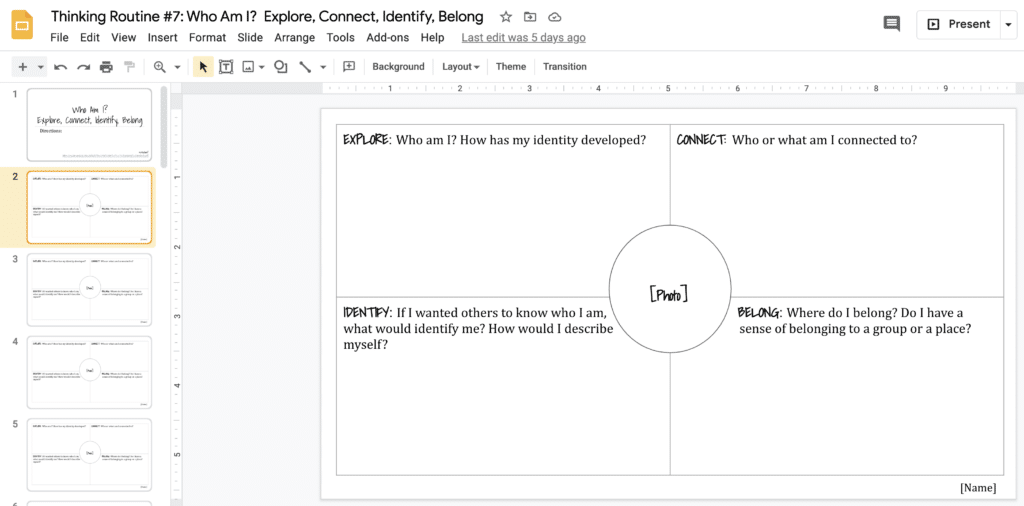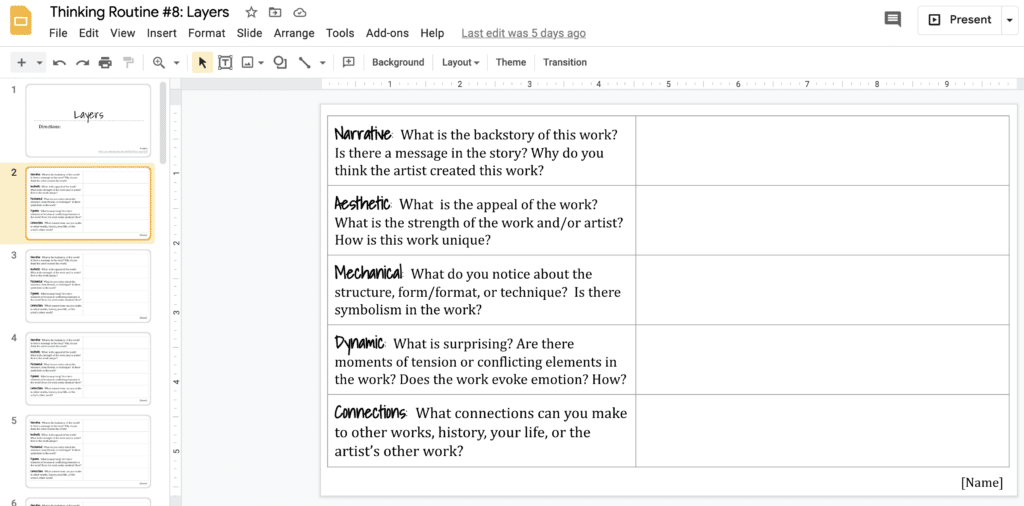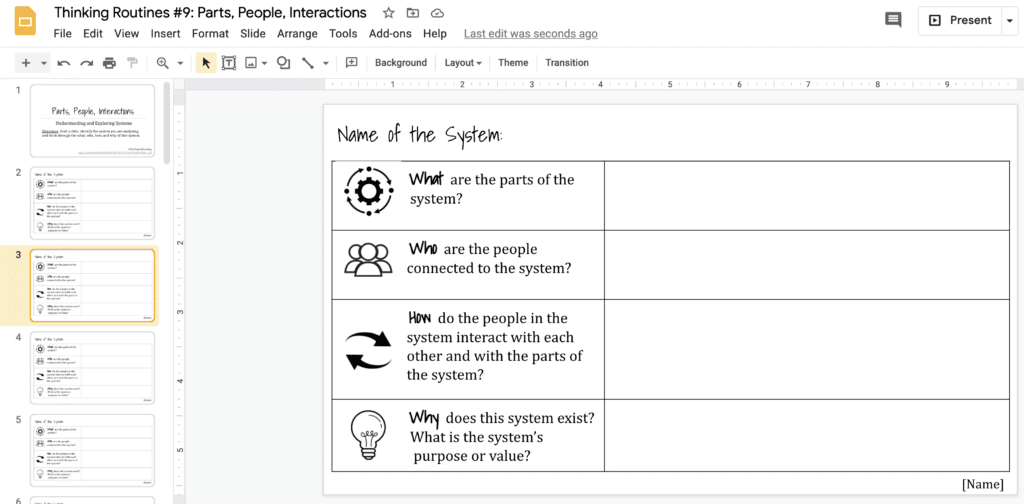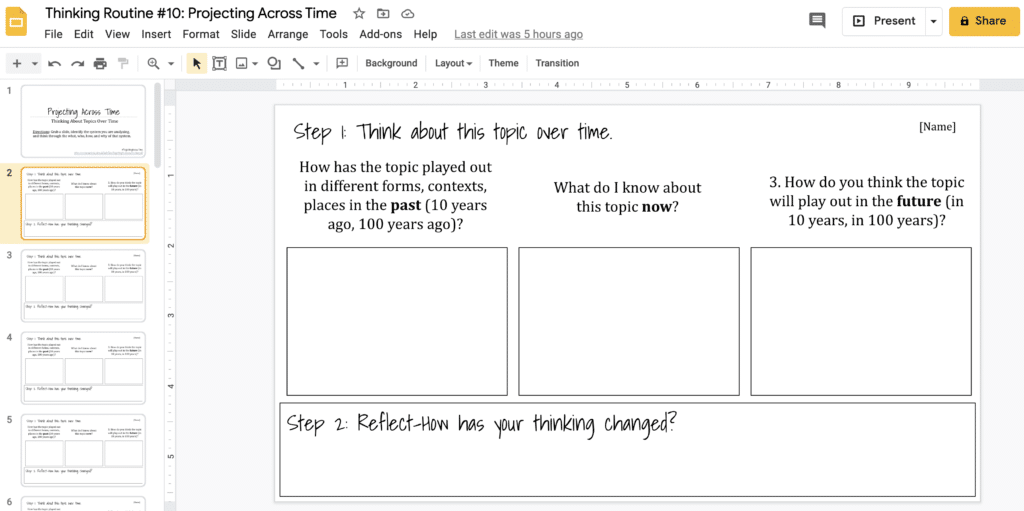In a previous blog, I shared a collection of thinking routines developed and published by Project Zero at Harvard’s Graduate School of Education. These routines are incredibly effective structures to encourage students to think more deeply about ideas, concepts, processes, and issues.
The Project Zero team presents a clear rationale for each routine (in English and Spanish), providing an explanation of the purpose of each routine as well as an explanation of how to apply the routines. I highly recommend checking out their entire collection!
Given that so many teachers are working with students online, on a hybrid schedule, or in concurrent classrooms, I have taken five more thinking routines and formatted them in Google Slide decks to make them easy to use in the online environment. By engaging a group or the entire class on a single slide deck, students can both share their thinking and learn from one another. It also simplifies the workflow for teachers because all of the students’ work is in a single location.
Each of the thinking routine titles below are linked to the corresponding Project Zero’s PDF explaining the why and how of the routine. If you click the image, you will be prompted to make a copy of the deck so you can modify and use it with your students.
Thinking Routine: See, Think, Me, We
Teachers using artwork, images, photography, or any form of visual media can use the See, Think, Me, We thinking routine to help students think critically about the media as well as make connections to their own lives and the world beyond.

Thinking Routine: Who Am I? Explore, Connect, Identity, Belong
The Who Am I? thinking routine encourages students to explore the complex nature of identity. This routine can be used to ask students to explore their own identity, but I can also imagine using this activity to encourage critical thinking about characters in novels or important figures from history.

Thinking Routine: Layers
The Layers thinking routine is designed to drive deeper thinking about the different layers within a piece of art (e.g., literature, visual art, performance art).
As an English teacher, I know how challenging it is to get students to dig deep and analyze the layers in a poem, short story, or novel. This routine guides students in reflecting on the various layers present in artwork to better understand the piece. Teachers can assign different layers to different groups of students or select particular layers based on the type of artwork students are analyzing.

Thinking Routine: Parts, People, Interactions
The Parts, People, Interactions thinking routine is perfect for analyzing systems to understand the parts of a system, who is connected to the system, how people interact in the system, and why the system exists.

Thinking Routine: Projecting Across Time
The Projecting Across Time thinking routine encourages students to consider a topic or issue over time. They begin with the center square considering what they know about the topic or issue right now, then explore how the topic or issue played out in the past and make predictions about what they think will happen in the future.

I hope this second collection of thinking routines are useful in engaging students in analysis and reflection regardless of the learning landscape they are working in.



11 Responses
Thank you so much for sharing such useful resources!
You’re welcome, Jennifer!
I love these activities, and now to have them in this format is a joy. Thank you!
You’re welcome, Ann!
I came to you after seeing the creatives on Twitter. A good & on-point presentation made by you. This helps the online learning community a lot. Thanks for sharing it with us.
Cheers
Jay
Thank you for the kind note, Jay!
Take care.
Catlin
I found the different Thinking Routine questions got me to thinking. I know that is what they are suppose to do but I wasn’t expecting to get so into my thoughts as I did. It will be interesting to see how I may use them on my students.
Thank you Dr. Catlin Tucker. Can you suggest a book that I can read to desing my own critical thinking questions.
Hi Cynthia,
I’ve heard good things about Fact Vs. Fiction: Teaching Critical Thinking Skills in the Age of Fake News and love anything by Jay McTighe. Jay’s new book Teaching for Deeper Learning: Tools to Engage Students in Meaning Making
Teaching for Deeper Learning: Tools to Engage Students in Meaning Making has some great strategies. I also love his work on essential questions, which is powerful though different from critical thinking questions.
Take care.
Catlin
I love these ideas and am so appreciative of you sharing! I did want to bring to your attention a typo on the See, Think, Me, We slides. It’s in the background and not editable. Under “Think” it says “thinkinking.”
Hi Amy,
Thanks for the heads up! I have edited that slide, so it should be good to go now. You can also edit the slides by clicking “View” > “Theme builder” in case you want to change the font or wording.
https://docs.google.com/presentation/d/1POjP0Js71EO5dORj-oUXw660Gs6yNFSgMRYoks6xjiI/edit#slide=id.ga8b7894ed6_0_36
Take care.
Catlin